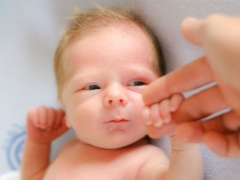Grasp reflex in newborns
In order for the newborn infant to adapt to the conditions of life after giving birth, it has a number of physiological unconditioned reflexes. Checking them, doctors are convinced that everything is in order with the baby, or they reveal different health problems of the baby. Some of the reflexes are very important for the development of motor skills as the baby grows. One of these reflexes can be called prehensile.
What is it
This is one of the most ancient human reflexes that occurs immediately after birth. He is considered physiological at the age of the first three or four months, after which, on the basis of such a reflex, the skill to arbitrarily seize objects is formed.
To cause this reflex, you need to press on the palm of the baby. The crumb will immediately grip your finger, sometimes so tightly that the baby can be pulled up. Similar action can cause the manifestation of the grasping reflex on the legs - if you put your thumb on the foot, the fingers will bend.
About prehensile and some other innate reflexes, see the video:
Stages of development of the conditioned reflex
There are four stages, during which a conditioned grasping reflex is formed:
- Stage 1 - in the first and second month of life. At this stage, the baby will grab the adult's fingers when pressed on the palm reflexively and unconsciously.
- Stage 2 - at the age of three months. The baby has not yet learned how to consciously grab items, but it becomes animated when he sees toys suspended above the crib. Trying to seize them, he improves the coordination of hand movements.
- Stage 3 - from the fourth to the eighth month of life. During this period, the baby learns to independently hold any objects and toys that attracted him. By the end of this stage, the crumb keeps them fairly well, but it is not yet cleverly handled with pens.
- Stage 4 - from the ninth month to a year. At this stage, the child perfectly captures objects using both hands. Often, to take away an unsafe object, parents have to make great efforts, releasing it from their tenacious and strong toddler pens.

Identifying problems for grasping reflex
- If a child has a paresis of arms, the grasp reflex will be weakened or disappear.
- The weakening of this reflex is noted when the nervous system is inhibited, and with increased excitability, the reaction will be enhanced.
- If the physiological grasping reflex is triggered by the age of 4-5 months, this can be a sign of problems with the nervous system.
What to do if the reflex is weak or absent
The absence or too weak manifestation of the grasping reflex in the infant during the first months of life should be the reason for a more detailed examination of the crumbs. The child should be examined by a neurologist, checking other reflexes to rule out neurological pathology.
Sometimes the manifestation of the grasping reflex is affected by the reduced muscle tone of the baby. This problem is solved by special massage courses.
In order to stimulate the development of a conscious grasping reflex, parents should invent more games in which the infant will grab objects with his hands. For example, you can put a bright toy next to the baby and wait until it finds itself in the hands of a toddler.
If a child has not learned to grasp objects consciously by the age of 9 months, this should also be a reason for going to the doctor.












